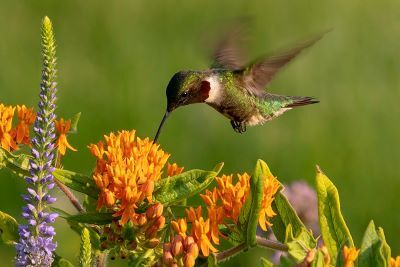
Good Natured: Hummingbirds Part 2
Last week we explored how the tiny winged jewels we know as hummingbirds fill their teensy tummies with--surprise, surprise!—that breakfast (and lunch and dinner) of champions: Arthropods.
Insects and spiders, and even insects in spider webs, combine to account for as much as 80% of a hummingbird's diet during the breeding season when demands for proteins and fats are high.
But what about that other food? The one that if on a human menu would be listed under Beverages?
Nectar is another essential component to the hummingbird's diet. The carbohydrates it provides help keep a ruby-throated hummingbird's wee wings moving at the astounding speed of 50 beats or more per second. The question then becomes, what source of nectar is best?
The National Audubon Society and just about every naturalist I know, myself included, recommend native plants over sugar-water feeders. Plants are not only the most natural source of food but also—for naturally lazy people like me—a source that doesn't require daily cleaning and monitoring.
The birds prefer flower nectar too! Several studies have shown that when flowers are in abundance, hummingbird visits to feeders decrease.
Visit any garden center and I guarantee you'll find a list of hummingbird-attracting plants as long as your arm: fuchsia, impatiens, nicotiana, nasturtium, petunia, rhododendron, and salvia to name a few. But while these flowers have vivid hues and bell-shaped or tubular flowers, which hummingbirds are well adapted to access, none of these blooms are native to Illinois.
Why does this matter? After all, hummingbirds migrate south to, at the very least the Gulf Coast states and, often, to Central America where tropical ornamentals abound.
The thing is, while the birds might not display a preference, the arthropods do. Most native insects require native plants to complete their life cycles. Thus in one swell foop these flowers provide everything the hummers need and, indeed, have adapted to over the last several thousand years.
The list of native plants hummingbirds visit is extensive but a few are noted for being hardy and vigorous—that is, easy to grow: wild columbine (Aquilegia canadensis); beardtongue (Penstemon spp.); bergamot/bee balm (Monarda fistulosa); milkweeds (Asclepias spp.); cardinal flower (Lobelia cardinalis); blue lobelia (L. siphilitica); obedient plant (Physostegia virginiana); and orange and yellow jewelweeds (Impatiens capensis and I. pallida). Short on space? Many of these plants also do well in containers.
But…and there's always a but, isn't there? Let's face it. Offering sugar water, especially as we move into the migration months, is an option many hummer fanciers can't resist. In fact, if they haven't bought themselves a nectar feeder, chances are their friends have presented them with one, or some, or several.
Available in a dizzying array of colors, shapes and sizes, these objects (and objets d'art) often are designed to suit humans' sense of utility and style. It's important to remember, though, that the actual aim is a feeder that is safe and helpful for the birds.
Experts at the Cornell Lab of Ornithology recommend two main criteria for selecting hummingbird feeders: size and ease of cleaning. Smaller is better, with the preference being for units that will be emptied within one to two days. And add nectar guards or choose a feeder without yellow “flowers" around the feeding ports if you want to discourage bees and wasps. Other tips for safe feeding include:
Use a 1:4 ratio of white (refined) sugar to water during hot, dry weather, and a 1:3 mix on cold, damp days; these concentrations mimic the concentration variations found in natural nectars. Also, even though the sugar will dissolve in cold or room-temperature water, boiling it will speed the mixing and neutralize any impurities in the water.
Do not, under any circumstances, no matter how persuasive the marketing may be (“Hummingbirds love the color red!") never, never, ever put any dyes, red or otherwise, into the sugar-water solution.
Hang the feeder out of direct sunlight. Hot rays speed solution spoilage.
Given hummingbirds' tendency toward territoriality, several small feeders widely spaced are better than one large feeder with many ports.
Thoroughly clean feeder(s) at least twice a week with either very hot water or a dilute bleach solution (1 part bleach to 9 parts water. Scrub the inside of the reservoir as well as the feeding port(s). If using the bleach solution, allow the feeder to thoroughly air dry to let the chlorine to dissipate.
Consult your local Audubon chapter for advice on when to put feeders out (early to mid May is “usual" in northern Illinois) and leave them up few weeks past when the last hummer is seen, just in case stragglers appear.
Pam Otto is the outreach ambassador for the St. Charles Park District. She can be reached at potto@stcparks.org.

